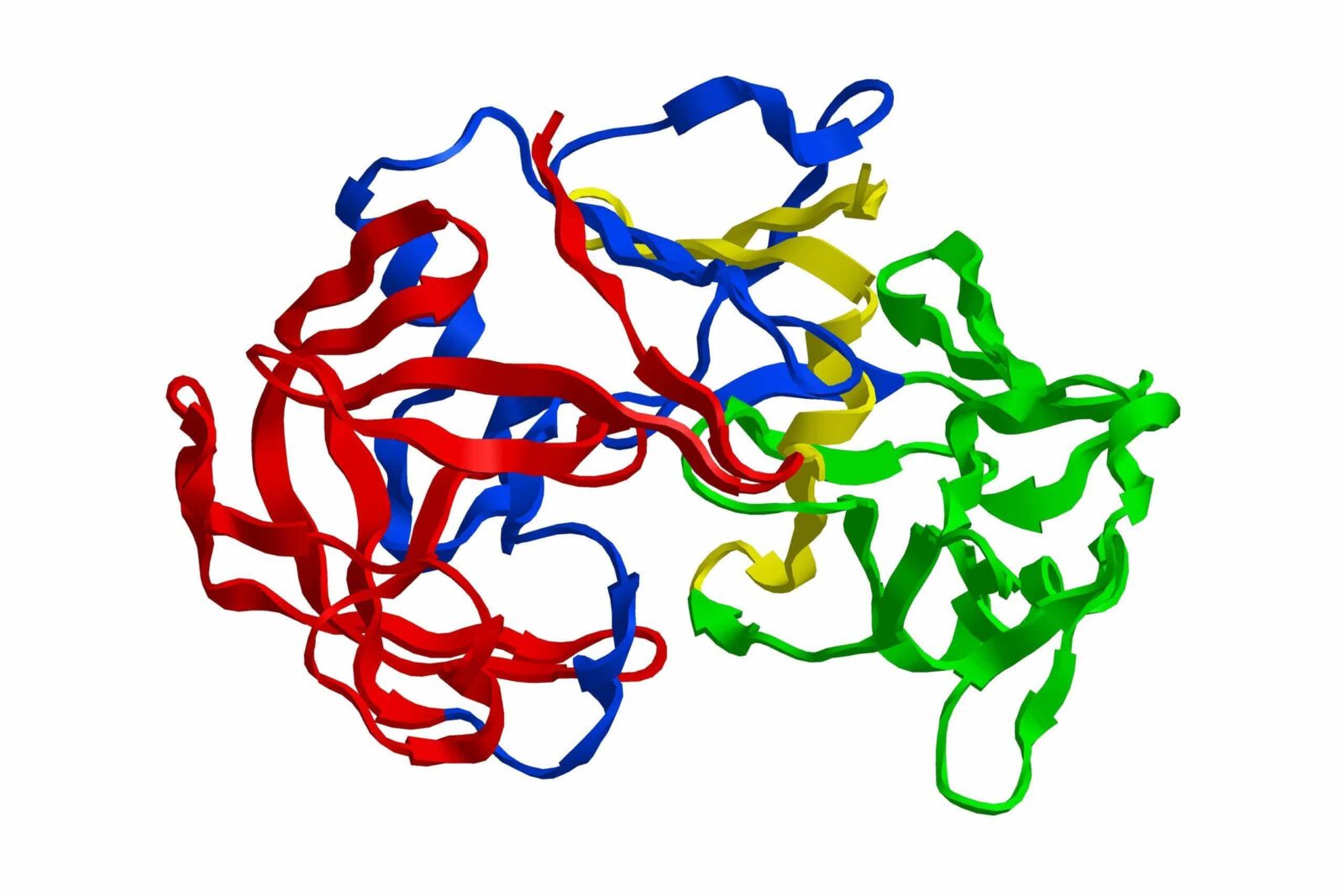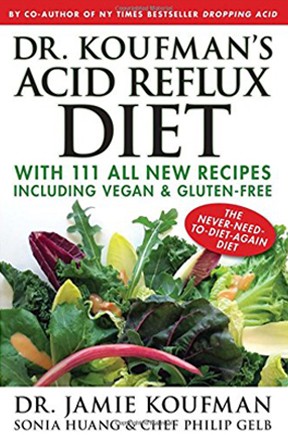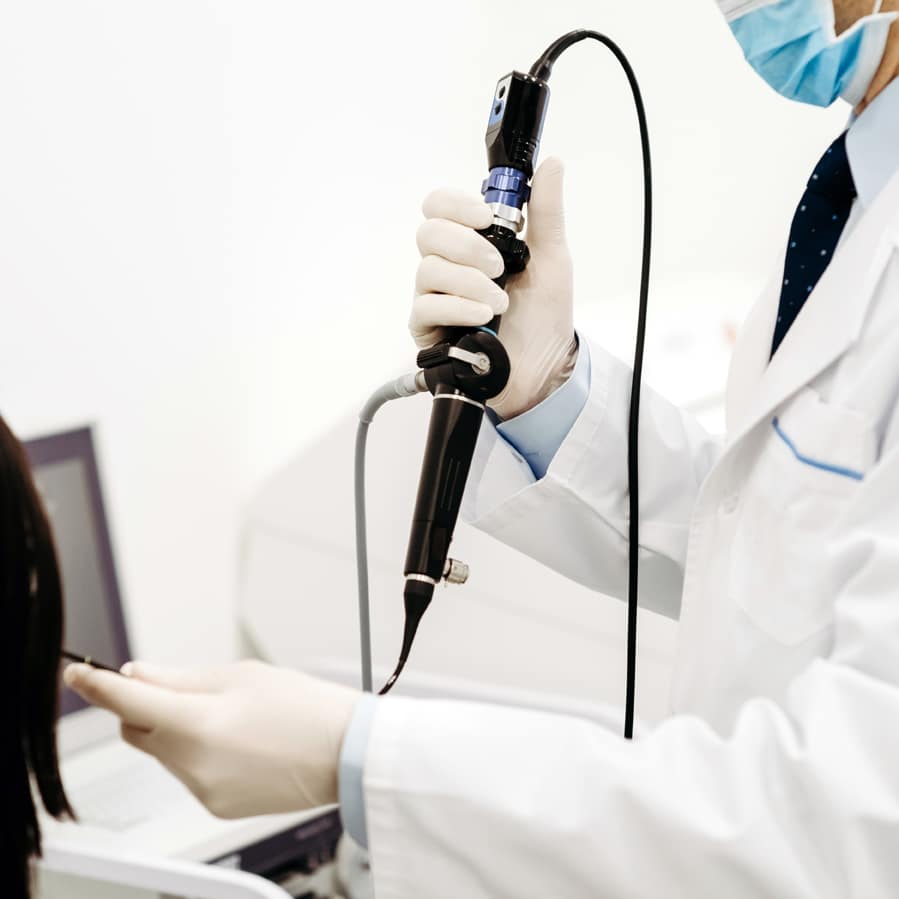
What Is PEPSIN?
At-A-Glance
- Most physicians mistakenly subscribe to the GI (gastroenterology) model of acid reflux disease, but it’s wrong, ALL WRONG! (1). Reflux is not about heartburn and indigestion; far more common is having reflux without GI symptoms, Silent Respiratory Reflux; (2). Endoscopy (looking in the esophagus) is not a useful test to determine if you have reflux; (3). By themselves, purple pills (PPIs) are ineffective anti-reflux treatment; (4). Reflux is not necessarily a chronic disease; it can be reversed with a healthy diet and lifestyle; (5). And Most Important: Successful Anti-Reflux Treatment Depends on Eradication of PEPSIN. (The problem isn’t acid.)
- Acid Reflux more accurately might be termed Peptic Reflux because pepsin—the main digestive enzyme of the stomach—is responsible for causing a diverse array of reflux-related, mostly respiratory, symptoms and diseases,1-18, 40-43 including aero-digestive tract cancers.4, 12, 17, 20, 22-24
- Pepsin is a proteolytic (breaks down protein) enzyme, which requires some acid for its activation; the more acid, the more potent pepsin becomes. Human pepsin is active from pH 0-8, with esophageal damage occurring at pH <4, and airway (respiratory tract) damage at pH <5. 4, 5, 18, 25, 26
- Currently, there are no effective medications for reflux, especially for laryngopharyngeal reflux (LPR). PPIs, which (only) partially-inhibit stomach acid production, are often prescribed for LPR; in fact, at least $26 billion per year is spent on them.26 Clinical trials, however, have failed to show PPIs to be of any significant therapeutic benefit.27-37 17, 19-24
- N-Zyme Biomedical is pioneering new anti-pepsin, anti-reflux therapies by repurposing Fosamprenavir. This drug is a protease inhibitor that binds to and inhibits pepsin.38 Far superior to acid-suppressive medications like Nexium or Prilosec (PPIs), pepsin-targeted drugs will transform reflux treatment.
References are provided in this post because I (JK) feel that certain, important, seem-to-have-been-mostly-overlooked, scientific research papers should be in the public domain … mainly for interested physicians, researchers and scientists.
Disclosure: The author (JK) is an N-Zyme Biomedical medical adviser and stockholder.
Function of Pepsin: What Does Pepsin Do?
Pepsin is a protease, a powerful enzyme that breaks down protein. It is so potent that scientists use “pepsinization” (usually with pig pepsin), as the first step in biochemistry to break down very large molecules into their component parts.
The idea that Acid Reflux is really Peptic Reflux is based on the science and cell biology, that is, how pepsin affects tissues and organs at a cellular level.1-18, 20, 21, 23, 24 Nikki Johnston and I have done much of the work, having reported how pepsin disrupts many cellular functions and causes inflammation, even neoplasia (cancer).1-4, 6-8, 10, 12, 16, 20, 24, 29, 40, 44
Shown under the microscope (photo below) is the histopathology of an ulcer of the vocal cord in a patient with Silent Reflux and hoarseness.40 This biopsy is stained for pepsin; the brown material is pepsin. You can see pepsin on the surface, in the tissue and even within inflammatory cells.

This is classic inflammation, most intense (dark area) over the ulcer. When combined with clinical data,41-43 this photo tells the story: Pepsin is the cause of reflux-related inflammation and tissue damage.1-21, 39, 40, 45, 49 Reflux laryngitis can also lead to vocal cord nodules, polyps and cancer; and similar effects can be seen in the nose, throat, voice box, sinuses and lungs. The causal link between pepsin and cancers of the aerodigestive tract (throat, esophagus, lung) has been established.17, 20, 22-24, 44, 45 In one study, we found pepsin in every laryngeal cancer biopsy.4 And after 40 years working in this field, I believe that one can get cancer without smoking, but not without reflux. And that’s all of them, laryngeal, pharyngeal (throat), esophageal and lung.
Pepsin is a protease, a powerful enzyme that breaks down protein. It is so potent that scientists use it, “pepsinization,” usually with pig pepsin, as the first step in biochemical analysis by breaking down large molecules into their component parts.
The idea that acid reflux is really peptic reflux is based on the science and cell biology, that is, how pepsin affects tissues and organs at a cellular level.1-18, 20, 21, 23, 24 Nikki Johnston and I have done much of the work; we have reported that pepsin disrupts many cellular functions and that it is the cause of inflammation, even neoplasia (cancer).1-4, 6-8, 10, 12, 16, 20, 24, 29, 40, 44
Shown (under the microscope) in the photo below is the histopathology of an ulcer of the vocal cord in a patient with silent reflux and hoarseness.40 This biopsy tissue is stained for pepsin, and the brown material is the pepsin. You can see pepsin on the surface, in the tissue, and even within inflammatory cell
When It Comes to Reflux Science, Pepsin Matters
Here is some science that you should know if you have reflux, because understanding how pepsin works, and how to get rid of it, are key to successful treatment.4-7, 10, 12, 40, 46 Remember that pepsin needs some acid to turn it on,5 and it is denatured (dies) at pH 9.5,46

Here is the pepsin activity curve.5 It shows that pepsin has 100% of activity at pH 2—the same pH as many soft drinks like Coca Cola—and 50% peptic activity at pH 5. Almost all soft drinks are pH <5, acidic enough to make soft drinks the number-one dietary risk factor for reflux.40 Yes, soda is very bad for refluxers! Don’t believe me? Purchase some pH paper to test the beverages that you drink for “pH-safety.” This is why I prohibit all bottled beverages as part of a Reflux Detox treatment program; see Dropping Acid: The Reflux Diet Cookbook & Cure. During this first phase, I recommend consuming nothing below pH 5.40,43
Meanwhile, there is still a small amount of peptic activity at pH 6. But pepsin is denatured, broken down, dies at pH 9.5,46 That’s why I recommend drinking alkaline water pH >9 and consumption of a low-acid diet during the initial phase of treatment.40, 43, 46
Pepsin Detection as a Diagnostic?
Pepsin is an excellent marker for reflux and it may be detected in tissue biopsies and in the saliva of people with LPR.47 I started work on developing a spit-in-a-cup pepsin assay in 1986. My epiphany and inspiration came when I learned that police forensics had a test for vomit based upon detecting a pepsin-like enzyme.
My work on developing a pepsin assay was patented in 1996.48 I never brought this test to market, because our internal data suggested that a one-time sampling was inaccurate, that is, people with reflux were often negative, and people without reflux were sometimes positive. I feel that spit-tests for pepsin (e.g., Peptest) do not have much value as diagnostic tests go. Far better would be an examination by an ENT physician who knows what s/he’s looking at.
New Anti-Pepsin Anti-Reflux Treatment with Fosamprenavir
Clinical trials have failed to demonstrate a therapeutic benefit of PPIs for LPR.26-28, 32, 49, 50 N-Zyme Biomedical aims to provide a pepsin-inhibitor (Fosamprenavir) as the first safe, effective and efficient treatment for LPR (laryngopharyngeal reflux), addressing a significant unmet clinical need.38
- Fosamprenavir is an FDA approved retroviral therapy for HIV/AIDS.38 It is well-tolerated and targets a foreign virus not present in most people; so it is ideal to repurpose, potentially allowing safe assessment in planned phase 3 clinical trials.38
- Fosamprenavir binds to pepsin and inhibits its enzymatic activity. It has been shown to abrogate pepsin-mediated laryngeal inflammation and mucosal damage in an established in vivo mouse model of LPR.38
- Epidemiology data support its efficacy: 5/2062 (0.2%) patients taking an HIV-inhibitor have LPR, compared to 10-34.4% of the general population.38
At present, N-Zyme Biomedical anticipates using Fosamprenavir in an inhaler and in pill form. I will keep you, my readers, abreast of the progress of research as data become available. For potential investors contact N-Zyme Biomedical.
References
I normally would not normally include so many references in a blog; however in this case, I believe that the cited papers are important and much-overlooked, ignored. Perhaps, that’s because Dr. Nikki Johnston’s and my cell biology work was published in the otolaryngology (ENT) literature, and most ENT doctors don’t read basic science articles; and perhaps most scientists and physicians in other fields don’t read the otolaryngology literature.
- Axford SE, Sharp N, Ross PE, Pearson JP, Dettmar PW, Panetti M, Koufman JA. Cell biology of laryngeal epithelial defenses in health and disease: preliminary studies. Ann Otol Rhinol Laryngol. 2001;110(12):1099-108. Epub 2002/01/05. doi: 10.1177/000348940111001203. PubMed PMID: 11768697.
- Gill GA, Johnston N, Buda A, Pignatelli M, Pearson J, Dettmar PW, Koufman J. Laryngeal epithelial defenses against laryngopharyngeal reflux: investigations of E-cadherin, carbonic anhydrase isoenzyme III, and pepsin. Ann Otol Rhinol Laryngol. 2005;114(12):913-21. Epub 2006/01/24. doi: 10.1177/000348940511401204. PubMed PMID: 16425556.
- Hurley BP, Jugo RH, Snow RF, Samuels TL, Yonker LM, Mou H, Johnston N, Rosen R. Pepsin Triggers Neutrophil Migration Across Acid Damaged Lung Epithelium. Sci Rep. 2019;9(1):13778. Epub 2019/09/26. doi: 10.1038/s41598-019-50360-4. PubMed PMID: 31551494; PMCID: PMC6760148.
- Johnston N, Bulmer D, Gill GA, Panetti M, Ross PE, Pearson JP, Pignatelli M, Axford SE, Dettmar PW, Koufman JA. Cell biology of laryngeal epithelial defenses in health and disease: further studies. Ann Otol Rhinol Laryngol. 2003;112(6):481-91. Epub 2003/07/02. doi: 10.1177/000348940311200601. PubMed PMID: 12834114. PDF Full Article
- Johnston N, Dettmar PW, Bishwokarma B, Lively MO, Koufman JA. Activity/stability of human pepsin: implications for reflux attributed laryngeal disease. Laryngoscope. 2007;117:1036-9. Epub 2007/04/10. doi: 10.1097/MLG.0b013e31804154c3. PubMed PMID: 17417109. PDF Full Article
- Johnston N, Dettmar PW, Ondrey FG, Nanchal R, Lee SH, Bock JM. Pepsin: biomarker, mediator, and therapeutic target for reflux and aspiration. Ann N Y Acad Sci. 2018;1434(1):282-9. Epub 2018/05/19. doi: 10.1111/nyas.13729. PubMed PMID: 29774546.
- Johnston N, Knight J, Dettmar PW, Lively MO, Koufman J. Pepsin and carbonic anhydrase isoenzyme III as diagnostic markers for laryngopharyngeal reflux disease. Laryngoscope. 2004;114(12):2129-34. Epub 2004/11/27. doi: 10.1097/01.mlg.0000149445.07146.03. PubMed PMID: 15564833. PDF Full Article
- Johnston N, Wells CW, Blumin JH, Toohill RJ, Merati AL. Receptor-mediated uptake of pepsin by laryngeal epithelial cells. Ann Otol Rhinol Laryngol. 2007;116(12):934-8. Epub 2008/01/26. doi: 10.1177/000348940711601211. PubMed PMID: 18217514.
- Johnston N, Wells CW, Samuels TL, Blumin JH. Pepsin in nonacidic refluxate can damage hypopharyngeal epithelial cells. Ann Otol Rhinol Laryngol. 2009;118(9):677-85. Epub 2009/10/09. doi: 10.1177/000348940911800913. PubMed PMID: 19810610.
- Johnston N, Wells CW, Samuels TL, Blumin JH. Rationale for targeting pepsin in the treatment of reflux disease. Ann Otol Rhinol Laryngol. 2010;119(8):547-58. Epub 2010/09/24. doi: 10.1177/000348941011900808. PubMed PMID: 20860281.
- Klimara MJ, Johnston N, Samuels TL, Visotcky AM, Poetker DM, Loehrl TA, Blumin JH, Bock JM. Correlation of salivary and nasal lavage pepsin with MII-pH testing. Laryngoscope. 2020;130(4):961-6. Epub 2019/07/23. doi: 10.1002/lary.28182. PubMed PMID: 31329290.
- Koufman JA. The otolaryngologic manifestations of gastroesophageal reflux disease: a clinical investigation of 225 patients using ambulatory 24-hour pH monitoring and an experimental investigation of the role of acid and pepsin in the development of laryngeal injury. Laryngoscope. 1991;101(4 Pt 2 Suppl 53):1-78. Epub 1991/04/01. doi: 10.1002/lary.1991.101.s53.1. PubMed PMID: 1895864.
- Luebke K, Samuels TL, Chelius TH, Sulman CG, McCormick ME, Kerschner JE, Johnston N, Chun RH. Pepsin as a biomarker for laryngopharyngeal reflux in children with laryngomalacia. Laryngoscope. 2017;127(10):2413-7. Epub 2017/02/23. doi: 10.1002/lary.26537. PubMed PMID: 28224634.
- Marshall S, McCann AJ, Samuels TL, Blair A, Bonne V, Johnston N, Koufman J. Detection of pepsin and IL-8 in saliva of adult asthmatic patients. J Asthma Allergy. 2019;12:155-61. Epub 2019/06/20. doi: 10.2147/JAA.S205482. PubMed PMID: 31213853; PMCID: PMC6549784.
- Nagahama K, Yamato M, Nishio H, Takeuchi K. Essential role of pepsin in pathogenesis of acid reflux esophagitis in rats. Dig Dis Sci. 2006;51(2):303-9. Epub 2006/03/15. doi: 10.1007/s10620-006-3129-8. PubMed PMID: 16534673.
- Rees LE, Pazmany L, Gutowska-Owsiak D, Inman CF, Phillips A, Stokes CR, Johnston N, Koufman JA, Postma G, Bailey M, Birchall MA. The mucosal immune response to laryngopharyngeal reflux. Am J Respir Crit Care Med. 2008;177(11):1187-93. Epub 2008/03/08. doi: 10.1164/rccm.200706-895OC. PubMed PMID: 18323539; PMCID: PMC2643204.
- Samuels TL, Altman KW, Gould JC, Kindel T, Bosler M, MacKinnon A, Hagen CE, Johnston N. Esophageal pepsin and proton pump synthesis in barrett’s esophagus and esophageal adenocarcinoma. Laryngoscope. 2019;129(12):2687-95. Epub 2019/05/03. doi: 10.1002/lary.28051. PubMed PMID: 31046139.
- Samuels TL, Johnston N. Pepsin as a causal agent of inflammation during nonacidic reflux. Otolaryngol Head Neck Surg. 2009;141(5):559-63. Epub 2009/10/29. doi: 10.1016/j.otohns.2009.08.022. PubMed PMID: 19861190.
- Gaynor EB. Gastroesophageal reflux as an etiologic factor in laryngeal complications of intubation. Laryngoscope. 1988;98(9):972-9. Epub 1988/09/01. doi: 10.1288/00005537-198809000-00012. PubMed PMID: 3412096.
- Johnston N, Yan JC, Hoekzema CR, Samuels TL, Stoner GD, Blumin JH, Bock JM. Pepsin promotes proliferation of laryngeal and pharyngeal epithelial cells. Laryngoscope. 2012;122(6):1317-25. Epub 2012/05/10. doi: 10.1002/lary.23307. PubMed PMID: 22570308; PMCID: PMC3816638.
- Kelly EA, Samuels TL, Johnston N. Chronic pepsin exposure promotes anchorage-independent growth and migration of a hypopharyngeal squamous cell line. Otolaryngol Head Neck Surg. 2014;150(4):618-24. Epub 2014/01/01. doi: 10.1177/0194599813517862. PubMed PMID: 24376122; PMCID: PMC4423599.
- Kim SY, Park B, Lim H, Kim M, Kong IG, Choi HG. Increased risk of larynx cancer in patients with gastroesophageal reflux disease from a national sample cohort. Clin Otolaryngol. 2019;44(4):534-40. Epub 2019/03/19. doi: 10.1111/coa.13328. PubMed PMID: 30884136.
- Niu K, Guo C, Teng S, Zhou D, Yu S, Yin W, Wang P, Zhu W, Duan M. Pepsin promotes laryngopharyngeal neoplasia by modulating signaling pathways to induce cell proliferation. PLoS One. 2020;15(1):e0227408. Epub 2020/01/16. doi: 10.1371/journal.pone.0227408. PubMed PMID: 31940393; PMCID: PMC6961942.
- Samuels TL, Zimmermann MT, Zeighami A, Demos W, Southwood JE, Blumin JH, Bock JM, Johnston N. RNA Sequencing Reveals Cancer-Associated Changes in Laryngeal Cells Exposed to Non-Acid Pepsin. Laryngoscope. 2021;131(1):121-9. Epub 2020/03/24. doi: 10.1002/lary.28636. PubMed PMID: 32202667.
- Johnston N, Ondrey F, Rosen R, Hurley BP, Gould J, Allen J, DelGaudio J, Altman KW. Airway reflux. Ann N Y Acad Sci. 2016;1381(1):5-13. Epub 2016/10/28. doi: 10.1111/nyas.13080. PubMed PMID: 27310222.
- Francis DO, Rymer JA, Slaughter JC, Choksi Y, Jiramongkolchai P, Ogbeide E, Tran C, Goutte M, Garrett CG, Hagaman D, Vaezi MF. High economic burden of caring for patients with suspected extraesophageal reflux. Am J Gastroenterol. 2013;108(6):905-11. Epub 2013/04/03. doi: 10.1038/ajg.2013.69. PubMed PMID: 23545710.
- Eherer AJ, Habermann W, Hammer HF, Kiesler K, Friedrich G, Krejs GJ. Effect of pantoprazole on the course of reflux-associated laryngitis: a placebo-controlled double-blind crossover study. Scand J Gastroenterol. 2003;38(5):462-7. Epub 2003/06/11. doi: 10.1080/00365520310001860. PubMed PMID: 12795454.
- El-Serag HB, Lee P, Buchner A, Inadomi JM, Gavin M, McCarthy DM. Lansoprazole treatment of patients with chronic idiopathic laryngitis: a placebo-controlled trial. Am J Gastroenterol. 2001;96(4):979-83. Epub 2001/04/24. doi: 10.1111/j.1572-0241.2001.03681.x. PubMed PMID: 11316215.
- Hvid-Jensen F, Pedersen L, Funch-Jensen P, Drewes AM. Proton pump inhibitor use may not prevent high-grade dysplasia and oesophageal adenocarcinoma in Barrett’s oesophagus: a nationwide study of 9883 patients. Aliment Pharmacol Ther. 2014;39(9):984-91. Epub 2014/03/13. doi: 10.1111/apt.12693. PubMed PMID: 24617286. PDF of Full Article
- Kahrilas PJ. When proton pump inhibitors fail. Clin Gastroenterol Hepatol. 2008;6(5):482-3. Epub 2008/04/02. doi: 10.1016/j.cgh.2008.02.010. PubMed PMID: 18378500; PMCID: PMC2474735.
- Masaany M, Marina MB, Sharifa Ezat WP, Sani A. Empirical treatment with pantoprazole as a diagnostic tool for symptomatic adult laryngopharyngeal reflux. J Laryngol Otol. 2011;125(5):502-8. Epub 2011/03/02. doi: 10.1017/S0022215111000120. PubMed PMID: 21356141.
- Noordzij JP, Khidr A, Evans BA, Desper E, Mittal RK, Reibel JF, Levine PA. Evaluation of omeprazole in the treatment of reflux laryngitis: a prospective, placebo-controlled, randomized, double-blind study. Laryngoscope. 2001;111(12):2147-51. Epub 2002/01/22. doi: 10.1097/00005537-200112000-00013. PubMed PMID: 11802014.
- Reichel O, Dressel H, Wiederanders K, Issing WJ. Double-blind, placebo-controlled trial with esomeprazole for symptoms and signs associated with laryngopharyngeal reflux. Otolaryngol Head Neck Surg. 2008;139(3):414-20. Epub 2008/08/30. doi: 10.1016/j.otohns.2008.06.003. PubMed PMID: 18722223.
- Steward DL, Wilson KM, Kelly DH, Patil MS, Schwartzbauer HR, Long JD, Welge JA. Proton pump inhibitor therapy for chronic laryngo-pharyngitis: a randomized placebo-control trial. Otolaryngol Head Neck Surg. 2004;131(4):342-50. Epub 2004/10/07. doi: 10.1016/j.otohns.2004.03.037. PubMed PMID: 15467597.
- Tamhankar AP, Peters JH, Portale G, Hsieh CC, Hagen JA, Bremner CG, DeMeester TR. Omeprazole does not reduce gastroesophageal reflux: new insights using multichannel intraluminal impedance technology. J Gastrointest Surg. 2004;8(7):890-7; discussion 7-8. Epub 2004/11/09. doi: 10.1016/j.gassur.2004.08.001. PubMed PMID: 15531244.
- Wo JM, Koopman J, Harrell SP, Parker K, Winstead W, Lentsch E. Double-blind, placebo-controlled trial with single-dose pantoprazole for laryngopharyngeal reflux. Am J Gastroenterol. 2006;101(9):1972-8; quiz 2169. Epub 2006/09/14. doi: 10.1111/j.1572-0241.2006.00693.x. PubMed PMID: 16968502.
- Amin MR, Postma GN, Johnson P, Digges N, Koufman JA. Proton pump inhibitor resistance in the treatment of laryngopharyngeal reflux. Otolaryngol Head Neck Surg. 2001;125(4):374-8. doi: 10.1067/mhn.2001.118691. PubMed PMID: 11593175.
- Johnston N ST, Goetz CJ, Arnold LA, Smith BC, Seabloom D, Wuerta B, Ondrey F, Wiedmann T, Vuksanovic N, Silvaggi NR, MacKinnon AC, Miller J, Bock JM, and Blumin JH. Oral and inhalation administration of selected HIV protease inhibitors reverses pepsin induced damaged in a laryngopharyngeal reflux mouse model. JAMA Submitted for consideration for publication December 2021.
- Crapko M, Kerschner JE, Syring M, Johnston N. Role of extra-esophageal reflux in chronic otitis media with effusion. Laryngoscope. 2007;117(8):1419-23. Epub 2007/06/23. doi: 10.1097/MLG.0b013e318064f177. PubMed PMID: 17585281.
- Koufman JA SJ, Bauer MM. Dropping Acid: The Reflux Diet Cookbook & Cure. Reflux Cookbooks LLC, New York, NY (2010).
- Koufman JA, Amin MR, Panetti M. Prevalence of reflux in 113 consecutive patients with laryngeal and voice disorders. Otolaryngol Head Neck Surg. 2000;123(4):385-8. Epub 2000/10/06. doi: 10.1067/mhn.2000.109935. PubMed PMID: 11020172. PDF of Full Article
- Koufman JA. Laryngopharyngeal reflux 2002: a new paradigm of airway disease. Ear Nose Throat J. 2002;81(9 Suppl 2):2-6. PubMed PMID: 12353428.
- Koufman JA. Low-Acid Diet for Recalcitrant Laryngopharyngeal Reflux: Therapeutic Benefits and Their Implications. Ann Otol Rhinol Laryngol 120:281-287 (2011). PDF of Full Article
- Riley CA, Marino MJ, Hsieh MC, Wu EL, Wu XC, McCoul ED. Detection of laryngeal carcinoma in the U.S. elderly population with gastroesophageal reflux disease. Head Neck. 2019;41(5):1434-40. Epub 2019/01/27. doi: 10.1002/hed.25600. PubMed PMID: 30681216.
- Tan JJ, Wang L, Mo TT, Wang J, Wang MG, Li XP. Pepsin promotes IL-8 signaling-induced epithelial-mesenchymal transition in laryngeal carcinoma. Cancer Cell Int. 2019;19:64. Epub 2019/04/03. doi: 10.1186/s12935-019-0772-7. PubMed PMID: 30936780; PMCID: PMC6425698.
- Koufman JA, Johnston N. Potential benefits of pH 8.8 alkaline drinking water as an adjunct in the treatment of reflux disease. Ann Otol Rhinol Laryngol. 2012;121(7):431-4. doi: 10.1177/000348941212100702. PubMed PMID: 22844861. PDF Full Article
- Knight J, Lively MO, Johnston N, Dettmar PW, Koufman JA. Sensitive pepsin immunoassay for detection of laryngopharyngeal reflux. Laryngoscope. 2005;115(8):1473-8. Epub 2005/08/12. doi: 10.1097/01.mlg.0000172043.51871.d9. PubMed PMID: 16094128. PDF Full Article
- Koufman J. Methods and compositions for the diagnosis of extraesophageal reflux. United States Patent 5,879,897 (1996).
- Bardhan KD, Strugala V, Dettmar PW. Reflux revisited: advancing the role of pepsin. Int J Otolaryngol. 2012;2012:646901. Epub 2012/01/14. doi: 10.1155/2012/646901. PubMed PMID: 22242022; PMCID: PMC3216344.
- Ford CN. Evaluation and management of laryngopharyngeal reflux. JAMA. 2005;294(12):1534-40. Epub 2005/09/29. doi: 10.1001/jama.294.12.1534. PubMed PMID: 16189367.









